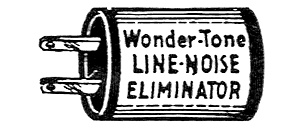|
BBC Top of Hour Announcement (MP3) Here's the classic "This is London," ID of the BBC World Service. It's the good one, not the weenie one they use now. It's followed, as it darn well ought to be, by the "Lilliburlero" folk tune, the time beeps, and the time in GMT, aka BBCMT since nobody keeps it in Greenwich any more. The BBCWS English service is definitely a tiny shell of its former self, so enjoy this wonderful ID as a reminder of better days. |
|
BBC Bottom of Hour (MP3) Lots of people associate Big Ben with the BBC, so here it is, even though BBC seems to be too hip to do this one much any more either. What's cool is that the bells are live. They briefly turn on a mike in the tower. If anyone's working up there, and they say something bad at the wrong time, well that's just a bloody bad show. |
|
Radio Prague ID (MP3) Radio Prague's trumpets and ID, right before Czechoslovakia broke up. Doppler processing is courtesy some really fine aurora. |
|
Radio South Africa Interval Signal (MP3) The old, and sorely missed, interval signal was once played for hours by Radio South Africa, with the guitar theme and the regional bird song. RSA is still on the air as of 2016, but as Channel Africa, with only one transmitter site active. |
|
Radio Moscow Interval Signal (WAV) Just the interval signal, with the weird vibrato. It's the first few bars of an old song called "Wide is my Motherland." At the height of the Cold War, R. Moscow was the biggest HF broacasting network in the world. Times changed, and it became the Voice of Russia in 1993. It grew ever smaller, and then went away altogether in 2014. Its replacement, Radio Sputnik, does not use short wave. |
|
Radio Pyongyang Sign On (MP3) (1999) Here's another Cold War relic, but this station is still on, louder than ever, as "The Voice of Korea." "Govarit Pyongyang" is Russian for "Pyongyang speaking." It's a transmitter ID used by the Russian-language broadcast service of the Democratic People's Republic of Korea, a land where 1953 never ended. Thrill to ominous 50-Hz hum, phase shifted interval signals, Brave People's Sign-On, and finally an appropriately distorted national anthem. Retro-cool audio clipping is all theirs, at no extra charge to Glorious Worker. |
|
Radiostantiya Tikhiy Okean Sign On (MP3) (1999) This time the transmitter signs on as "Vladivostok." This is followed by an IS, then a Russian language program identifying as "Radiostantiya Tikhiy Okean" ("Pacific Ocean Radio Station.") Tikhiy Okean appeared in logs as recently as 2005, but it is now apparently off-air. |
|
Radio Reloj on R. Havana (MP3) (1999) At one time, Radio Havana Cuba was usually more interesting after its sign-off for the night than when the program was on. The transmitter carrier stayed on for an unpredictable length of time. Everything from spy "numbers" to backward opera music appeared, fully modulated, in the interval. The best period was the one when, for reasons known only to the inscrutable brains of Cuban radio engineers, they ran anywhere from a minute to an hour of Radio Reloj ("Clock Radio"). It's the only time we ever got to hear this popular Cuban AM station that invented all-news radio, and probably post-modern AM in general, way back in the 1950s. RR had to be the tightest radio format ever devised. It was also one of the weirdest, with its ticking clock, Morse code "RR" at the top of every minute, and rapid-fire news in Spanish, invariably by two fast talkers who alternated deep breaths with 25-second stories. Remarkable. |
|
Norddeich Radio Channel Marker (MP3) (1989) Here in California, I heard this ominous time-bomb marker exactly once. It's USB, from Norddeich Radio, a maritime coastal station in Germany. It was in just long enough for me to start the tape, and in that halcyon age of 1989, it was indeed tape. Then the station faded - forever. Now it is off the air, replaced by GMDSS. |
|
Unintentional Avant-Garde Sky Musik (MP3) (1999) This concerto for ionosphere and orchestra left the transmitter as modern classical, but arrived here sounding more like Handel's Water Music after the boat sank. It has to be the heaviest phase distortion I've ever heard, and I've heard a lot of phase distortion. Probably Deutsche Welle by backscatter, but I became vaguely nauseous long before I could identify. You have been warned: DO NOT listen with a headache! |
|
WSHB Dual Path Echoes (MP3) (2000) This is the best example of dual-path echo I've ever recorded, in a Sunday broadcast of Christian Science Radio. This defunct service was the forerunner of WHRI, using the same Cypress Creek, SC flamethrower. The powerful transmitter is beaming away from California, and conditions are so good that signals come both the short way, about 2000 miles in this case, and the long way, pretty much clear around the world and delayed by the trip. Path losses perfectly offset antenna gain, and it's usually a tossup as to which echo is going to win. It's an awesome proof that we're living on a planet, but once again it's not the best idea to listen with a headache. |
|
Whale Sound Station #1 (MP3) (1999) This vaguely disturbing noise, heard here on 6817 kHz, has been likened to lonely whales, Frank Zappa music, and broken synthesizers. More likely, it's malfunctioning U.S. military equipment, though the few who know aren't telling. |
|
Whale Sound Station #2 (MP3) (2002) Here's an even better pod, heard on 2662 kHz. The low frequency moans are especially cool. |
|
Backward Music Station (MP3) (2015) The BMS is like the Whales, only higher and more tones at once. This one appears on 6693 kHz, and seems to be associated with the Russian VOLMET. |
|
Space Shuttle Sonic Booms (WAV) (2008) Well, OK, this isn't really off shortwave. The voice is via ham radio, through the speaker, but the space shuttle's twin sonic boom is live. If bad weather at Cape Canaveral moved the landing to Edwards AFB, and everything else was just right, L.A. would get a nice pair of booms like these. Imagine them rolling over the land like thunder, making walls shake. |
|
|
|
Here's the WWV "Geoalert" announcement for the last sunspot cycle's highest daily solar flux, a 327, in March of 1989. I actually drove across town, to the big solar telescope at the Griffith Observatory. The poor sun looked like a bad case of zits. Cycle 23 peaked in late 2000 with daily fluxes in the 250s. The less said about Cycle 24, the better. Now the science types are wondering if Cycle 25 will even be large enough to notice. |
|
|
|
This is a USB channel marker, probably from the 8 MHz band, once repeated day and night by LPL, General Pacheco Radio, a public maritime coastal radiotelephone station in Buenos Aires, Argentina. Note the rather tuneless, 5-note, musical theme at the beginning. I presume this was for getting receivers dead on-channel by ear. This marker vanished a few years back. For a while, there was sometimes a vaguely British Telecom-sounding ring tone on the frequencies, then - nothing. |
|
|
|
Clarion call and Spanish "Last News" (second coming?) program on this old U.S. Bible-thumper. |
|
|
|
This one always pops up in net discussions of the great moments in onda-corta. The poor NHK announcer is doing a pretty good job with his English until they make him say "chlorofluorocarbons". Hope he got combat pay. |
|
|
|
This is a genuine, Cold War relic, from the Greek language service of the Bulgarian National Radio. We hear a Communist youth march, then "Milai Sofia," ("This is Sofia") from the classic, propaganda-mill, male and female voices. Again, some truly impressive aurora. |
|
|
|
For whatever reason, RHC had two music cues before its top of hour ID. There was the lousy one, on the English language service, and this really great, tropical one on the Spanish broadcast. The flutes are much easier to hear on this one, when they send "RHC" in Morse code, and the horns will make you crave a rum and Coke. |
|
|
|
7255 kHz used to be a ham radio emergency frequency. Here's one of the reasons that it changed, before the ITU reallocated that part of 40 meters. We hear the signature talking drums, then part of the national anthem, finally a voice ID. The anthem always sounds just as out of tune live. Don't blame the recording! (Edited somewhat) |


